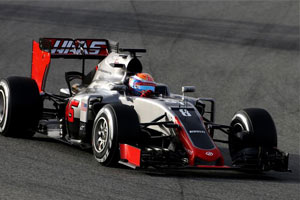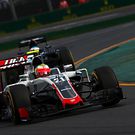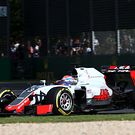Haas VF-16 Ferrari

Active: 2016
Team: Haas F1 Team
Team: Gene Haas (Chairman), Gunther Steiner (TP)
Drivers Romain Grosjean (8), Esteban Gutierrez (21)
The very first Haas F1 car was first unveiled by the team in pictures only, while behind the scenes the team managed to complete a shakedown run at Circuit de Catalunya before testing kicked off.
Powered by and partnered up with Ferrari, the team has had considerable technical support from the Scuderia, enabling the team to make a respectable debut in F1. The cooperation is this close that they have opted to get as many parts from Ferrari as allowed by the regulations, meaning they have Ferrari's entire drivetrain, gearbox and suspension components. The front suspension at least is as such identical as that of the Ferrari of 2016, with identical wishbones and pushrod. The chassis itself is not allowed to be a version raced by another team, so Haas decided to outsource its design and manufacturing to Dallara, an Italian company that happened to have a good working relationship with Ferrari as well.
Technically, the car may be considered somewhat traditional, but that could be expected from a completely new entrant. It still can be considered a very tidy package, with the car featuring a short nose - which is widely believed to be the more efficient solution under the set of regulations - that was certainly not easy to get through the crash tests. It's testimony to the team's efforts that they have not chosen to go for the easier solution of incorporating a long nose cone.
At the time of the launch, the sidepods were a clean design as well, but larger than what competing teams have on their cars. Haas has certainly gone for certainty here, as it's better to gain experience first, rather than pushing the cooling limit of the engine from the word 'Go'. Instead, measurements and running will enable to team to make considered design decisions on how to progress the package.
At its rear end, the car debuted with a monkey seat to aid in rear downforce generation. As exhaust gases pass just underneath, the team coated the inside of the carbon fibre elements with gold foil to protect the carbon fibre from burning, something other teams have previously experienced in 2014 and 2015. The layout of the exhaust system, including the main exhaust pipe and two additional wastegate outlet pipes is meanwhile identical to that of Ferrari.
On-track performance
The partnership has allowed Haas to import some elements that are crucial to a car's reliability, resulting in Grosjean completing 31 laps on the team's very first day of testing. Further testing was however overshadowed by repeated front wing failures, problems with the fuel feed and issues related to the imperfect turbo on the Ferrari power unit.
A clever strategy at the first race, the Australian GP immediately enabled Romain Grosjean to finish 6th, making Haas the first newcomer team to score points on their first race since Toyota in 2002.
After that positive note however, the team continued to struggle with brake consistency and had numerous retirements due to brake problems. Gunther Steiner confirmed later that their Brembo brakes were inconsistent from one set to another, leading to a test with Carbone Industrie brakes at the Brazilian Grand Prix weekend, as well as using a stronger material - supplied by Brembo - for the brake rotors, as of the Mexican Grand Prix. The team was however undecided after its test, carrying its brake problems over into 2017.
The VF-16 carried Haas F1 Team to an eighth-place finish in the 2016 constructor standings. Twenty-nine points were scored during Haas F1 Team’s inaugural season, the largest points haul of any new Formula One team in this millennium thus far.
Specifications
Chassis: Carbon-fibre monocoque
Front suspension: Upper and lower wishbones, inboard springs and dampers actuated by push-rods
Rear suspension: Upper and lower wishbones, inboard springs and dampers actuated by pull-rods
Dampers: ZF Sachs Race Engineering
Brakes: Brembo callipers and carbon fibre pads and discs
Transmission: Ferrari 8-speed quick-shift sequential carbon-cased gearbox, hydraulically activated. Longitudinally mounted
Clutch: Carbon fibre plates, by ZF Sachs
Differential: Servo controlled hydraulic limited-slip differential
Electronics: FIA standard ECU and FIA homologated electronic and electrical system (as provided by MES)
Tyres: Pirelli
Wheels: OZ, magnesium alloy
Dimensions
Height: 950 mm (minus T camera)
Track width: 1,460 mm (front); 1,416 mm (rear)
Weight: Undisclosed
Powertrain
Designation: Ferrari 059/3
Type: turbocharged, 90° 1.6l V6, assisted with kinetic and heat ERS
Valves: 24 (4 per cylinder)
Rev limit: 15,000rpm
Pressure charging: Single turbocharger, unlimited boost pressure (typical maximum 3.5 bar abs due to fuel flow limit)
Bore: 80mm
Stroke: 53mm
Crank height: 90mm
Exhaust: Single exhaust outlet, from turbine on car centre line, along with two outlet pipes connected to the wastegate
Injection: Direct fuel injection, limited to 500bar
Ignition: SKF spark plugs
Weight: Undisclosed (at least 145kg)
Total horsepower: Approximately 600hp (ICE) + 160hp (ERS)
Energy recovery system: Integrated Hybrid energy recovery via electrical Motor Generator Units
Energy Store: Lithium-Ion battery solution (up to 4MJ per lap), between 20 and 25 kg
Cooling system: Secan/Marston
Fuel and lubricants: Shell





